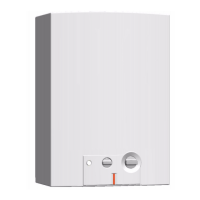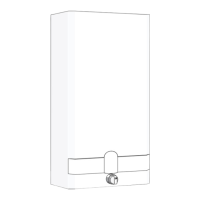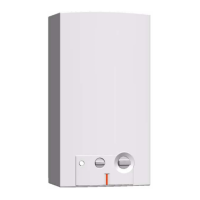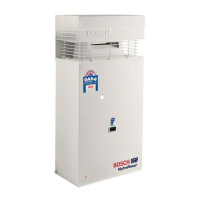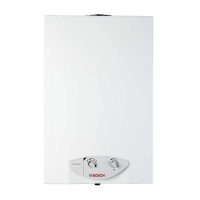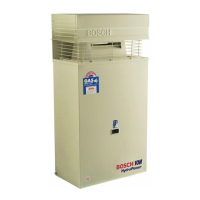
Do you have a question about the Bosch HP 200-1 E Al-F and is the answer not in the manual?
| Energy Source | Electric |
|---|---|
| Type | Storage Water Heater |
| Voltage | 230 V |
| Frequency | 50 Hz |
| Power | 2000 W |
Provides an overview of the water heater's components and identifies key parts with numbered labels.
Highlights environmentally friendly aspects and ease of use, along with inherent safety features of the appliance.
Explains the function of temperature-limiting controls that prevent excessively high water temperatures and require manual reset.
Specifies ideal ambient operating temperatures and the requirement for potable water to prevent damage.
Details the automatic cutoff mechanism when water temperature reaches 165°F to prevent overheating.
Explains the function of the T&P valve which opens at 150 PSI or 210°F to relieve pressure or temperature.
Presents detailed technical specifications for the water heater, including performance, dimensions, and component details.
Explains how the electric heat pump water heater works and outlines the different operating modes available.
Provides a diagram with the physical dimensions of the water heater in inches for installation planning.
Lists the necessary tools required for the proper installation of the water heater.
Specifies critical requirements for the installation location, including space, ventilation, and protection from damage.
Outlines the specifications for venting the water heater, including duct diameter, length, and elbow limitations.
Details the inlet and outlet water connections, including recommended practices and important warnings.
Explains the necessity of using dielectric unions to prevent corrosion between different metals in plumbing connections.
Details how to connect the condensate drain hoses, including overflow functions and pump requirements.
Covers the installation requirements for the T&P valve, emphasizing safety and proper discharge line connection.
Explains the concept of thermal expansion and the need for an expansion tank in closed water systems.
Details the electrical specifications, wiring requirements, circuit protection, and grounding necessary for safe operation.
Presents various ways to configure the water heater's installation, including using existing space heat and air recirculation modes.
Provides guidelines for applying an insulation blanket, emphasizing what not to cover for proper access and function.
Details the procedure for filling the water heater tank with water before turning on the power to prevent damage.
Lists recommended water quality levels and advises on treating water if it exceeds these limits to prevent product failure.
Describes the expected sequence of events and timings during the initial startup of the water heater.
Details the functions of each button on the control pad, including display, navigation, power, vacation, and mode selection.
Explains the meaning of various icons and indicators displayed on the unit's LCD screen for different modes and statuses.
Provides crucial safety warnings related to hydrogen gas, overheating, water filling, thermal expansion, and flammable vapors.
Guides users on how to set the water temperature, emphasizing safety considerations regarding scalding risks.
Explains the different operating modes (Auto, Economic, Electric) and their energy efficiency and performance characteristics.
Describes the Vacation mode feature, used to conserve energy during extended periods of non-use.
Details how to use button combinations for functions like unit conversion, parameter inquiry, and clearing malfunctions or alarms.
Provides step-by-step instructions on how to reset the temperature limiting control after it has tripped.
Recommends periodic inspections of operating controls, heating elements, and wiring by qualified service personnel.
Details the procedure for checking the operation of the T&P valve annually and addressing periodic discharge.
Explains how to flush the tank annually to remove accumulated solids and mineral deposits.
Provides instructions on how to safely shut off power and drain the water heater, including warnings about hot water.
Advises on turning off power and water for extended periods, draining if freezing is a risk, and checking controls.
Details the procedure for cleaning the air filter to maintain optimal efficiency and prevent system damage.
Explains how to clear debris from condensation drain tubes to prevent clogging and water spillage.
Emphasizes the importance of inspecting the anode rod for corrosion protection and recommends inspection frequency.
Addresses causes of noise, including normal fan operation and potential issues like dirty filters, and suggests solutions.
Explains that room cooling is a byproduct and suggests solutions if the room is too small or inadequately vented.
Identifies causes for dripping, such as disconnected or clogged condensate drain hoses, and provides connection and clearing steps.
Covers issues like high water usage, electrical supply problems, incorrect temperature settings, and leaks.
Addresses causes for water being too hot, including incorrect temperature settings, and recommends checking controls.
Suggests checking for scale buildup on heating elements as a cause for rumbling noise and recommends cleaning.
Explains that popping or draining may be due to thermal expansion in closed systems and advises against plugging the outlet.
Indicates that the filter requires cleaning for effective operation and directs users to cleaning instructions.
Notes that the unit will not make noise if it is using only the electric elements.
Provides steps to check wiring, sensors, interference, and actual temperatures for specific sensor error codes.
Addresses heat pump cycling, high temperatures, and suggests checking previous error codes for diagnosis.
Details specific operational conditions and causes such as incorrect temperature readings or high compressor current.
Lists checks for voltage, wiring, limiters, element damage, and resistance for heating element error codes.
Advises on recycling the packing box, confirmed by the recycling symbol, for environmental responsibility.
Informs users that many parts are recyclable and suggests contacting local authorities for disposal information.
Provides tips on closing taps, avoiding drips, and setting optimal temperatures to conserve water.
Stresses that refrigerant must be recovered by a qualified person at the end of the appliance's life and must not be vented.
Specifies that the warranty applies to Bosch Compress 3000 Water Heater models installed at the original place of installation.
Outlines the warranty terms for the first year (repair/replace including labor) and subsequent years (repair/replace excluding labor).
Clarifies that components not manufactured by Bosch are covered by their respective manufacturers' warranties.
Lists exclusions from the warranty, such as improper installation, normal maintenance, and damage from misuse or external factors.
Specifies conditions that will void the warranty, including improper operation, accident, misuse, and unauthorized alterations.
States Bosch's disclaimer of all other warranties, express or implied, including merchantability and fitness for purpose.
Details the steps for initiating a warranty claim, including contacting the installer, distributor, or Bosch directly.
